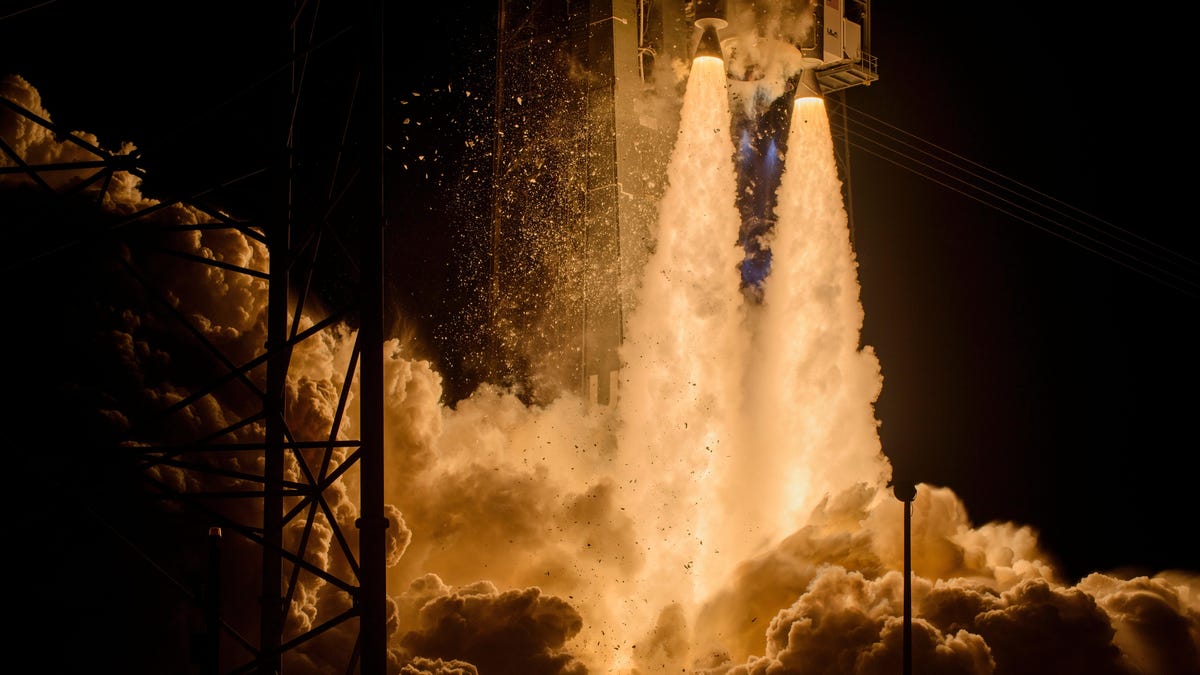
Astrobotic’s 6-foot-tall shiny probe ran into early trouble on its way to the Moon, and is currently unable to point its solar panels towards the Sun for power.
On Monday, Astrobotic’s Peregrine lander lifted off at 2:18 a.m. ET from Cape Canaveral’s Space Launch Complex-41. The commercial lunar lander launched atop United Launch Alliance’s (ULA) Vulcan Centaur rocket, which made its debut with the historic liftoff.
At around 50 minutes into its maiden flight, Vulcan deployed Peregrine at an altitude of approximately 310 miles (500 kilometers) above the Earth’s surface, where the lander separated from the rocket and powered on. Following separation, Astrobotic successfully contacted its lander and began receiving telemetry data through NASA’s Deep Space Network, according to the Pittsburgh-based company.
“Today Peregrine Mission One achieved a number of big milestones,” John Thornton, CEO of Astrobotic, said in an emailed statement. “Peregrine powered on, acquired a signal with Earth, and is now moving through space on its way to the Moon.”
Shortly after the statement was sent, however, Astrobotic issued an update stating that Peregrine is currently unable to achieve a stable Sun-pointing orientation due to an anomaly that’s preventing it from being able to charge its solar panels. “The team is responding in real time as the situation unfolds and will be providing updates as more data is obtained and analyzed,” Astrobotic wrote in an email. If Peregrine can’t recharge its batteries or sustain power, the mission will be unable to continue.
At around 11:06 a.m. ET, Astrobotic issued a second, more ominous statement. “The team believes that the likely cause of the unstable sun-pointing is a propulsion anomaly that, if proven true, threatens the ability of the spacecraft to soft land on the Moon,” the company wrote on X. “As the team fights to troubleshoot the issue, the spacecraft battery is reaching operationally low levels.”
Prior to a forecasted communication blackout, the team quickly implemented a contingency plan to adjust the spacecraft’s solar panels towards the Sun. This was done just prior to losing contact with the spacecraft, which entered its anticipated communication silence. Updates on Peregrine’s status will be shared once it re-establishes connection with the ground station.
This is an evolving story, and further details will be provided as more information becomes available.
Peregrine is packed with 24 different payloads from three national space agencies, with 11 payloads from NASA alone, as well as a host of other payloads from private companies. NASA’s payloads on board Peregrine include the Laser Retro-Reflector Array (LRA), which uses laser beams to accurately measure the distance between the Moon and Earth, and the Linear Energy Transfer Spectrometer (LETS), which measures radiation at the lunar surface for astronaut safety during future missions.
Other payloads include a swarm of tiny robots from Mexico, a time capsule from Carnegie Mellon that includes images, poems, music pieces, as well as the for two space memorial companies. The two companies, Celestis and Elysium Space, packed DNA (in the form of hair samples) and the cremated remains of more than 200 people on a space memorial mission, with customers buying a chance for their loved ones to be sent into deep space or buried on the Moon.
Related article: The Moon Is About to Become a Graveyard
The lander is scheduled for a lunar touchdown in February. So far, only NASA, the Soviet Union, China, and India have successfully landed on the Moon. Attempts by other nations have not ended well; Israel’s Beresheet crashed onto the Moon’s surface in April 2019, while India’s Vikram spacecraft did the same that September 2023. In April 2023, Japan’s ispace was also hoping to become the first private company to land on the Moon, but its Hakuto-R lander crashed on the surface.
Peregrine is part of NASA’s Commercial Lunar Payload Services (CLPS) initiative, which is meant to help the space agency in its quest to return humans to the Moon and make it a sustainable place for long-term human presence. It also ushers in a new era for private companies by granting them greater access to the lunar surface, for better or for worse.
The launch also welcomed a next-generation two-stage rocket capable of transporting payloads to various destinations, including low Earth orbit (LEO), geosynchronous orbit (GEO), as well as to the Moon and beyond for deep space exploration missions. “Vulcan’s inaugural launch ushers in a new, innovative capability to meet the ever-growing requirements of space launch,” Tory Bruno, ULA’s president and CEO, said in an emailed statement. “Vulcan will provide high performance and affordability while continuing to deliver our superior reliability and orbital precision for all our customers across the national security, civil and commercial markets.”
Since its establishment in 2006, ULA has delivered both commercial and government-owned payloads over 155 space missions with its Atlas V and Delta IV rockets. The introduction of its long-awaited Vulcan Centaur rocket could inch it closer to competing with industry giant SpaceX as it provides a similar level of affordability and access to space. ULA is planning on launching Vulcan at least seven more times this year.
Correction: An earlier version of this article failed to make note that India has also successfully landed a lander on the Moon, in addition to the United States, the Soviet Union, and China.
For more spaceflight in your life, follow us on X (formerly Twitter) and bookmark Gizmodo’s dedicated Spaceflight page.






